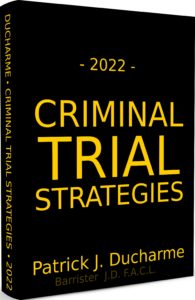The prosecution and the defence each have a chance to present evidence. The prosecution goes first. The prosecution has to prove the charge(s). The defence is not required to prove innocence. The defence is not required to prove anything except in rare specific instances clearly spelled out in the Code. Because accused persons are not required to prove their innocence they are not obliged to testify or to present evidence. Instead, the prosecutor is required to prove each essential element of an offence beyond a reasonable doubt.
After the prosecutor delivers her opening address to the jury, the prosecutor will call witnesses. The prosecutor may also file documents or items of evidence as exhibits. Facts that are admitted pursuant to section 655 of the Criminal Code by the defence may also be considered part of the prosecutor’s case. Such an admission disposes of the necessity of proof of that which is admitted by the defence.
If the defence chooses to present evidence, defence counsel may make an opening address after all the evidence has been called by the prosecution. In making their opening addresses, either side may refer to the evidence they intend to present, however, should avoid argument on the facts and, except for the very limited basis referred to below, avoid reference to the law. Even in closing addresses, reference by counsel to the law should be restricted and only for the purpose of making arguments as to the facts understandable as relevant. The trial Judge, after all the evidence has been heard, explains for the jury the applicable principles of law. The jury is to follow the instructions of the trial Judge. Opening addresses are permitted for the limited purpose of outlining for the jury the evidence that is anticipated. Consequently, if there is any reference to the law at all, it ought to be minimal and only for the purpose of explaining the relevance of the evidence that is anticipated.
During questioning of witnesses lawyers are required to follow certain procedural rules. The rules change depending upon whether or not the witness has been called by the lawyer asking the questions. The lawyer who calls the witness to the witness stand asks questions in “examination in chief.” Except in introductory matters or non-contentious matters the questions are not allowed to be leading, that is, they cannot by their nature suggest the answer to the witness.
Another set of rules applies to lawyers questioning witnesses that have been called by the opposition. These questions are in “cross examination”. Examination-in-chief always comes first; then the opposing lawyer is given an opportunity to cross-examine the same witness. When two or more accused persons are tried together, the defence lawyers are given an opportunity to cross-examine the witnesses called by other defence counsel before the prosecutor is provided an opportunity to cross-examine the witness.
After the witness has been cross-examined, the lawyer who called the witness to the stand may, but is not required to, ask additional questions to clarify or explain matters that have come up in cross-examination. This is referred to as re-examination. Re-examination is permitted for completeness and/or clarification of evidence that has been raised or introduced by cross-examination that if left alone would be incomplete, misleading or unclear. When re-examination is ended the evidence of the witness is complete.
One of the trickiest areas of our evidentiary rules relates to the recognition of and treatment of hearsay evidence. Hearsay evidence is presumptively inadmissible unless an exception to the hearsay rule applies. Inadmissibility is generally determined in circumstances where the evidence is thought to be unreliable. In fact, the whole basis of the rule against hearsay evidence is that it is essentially unreliable.
The above is the an excerpt of Patrick J Ducharme’s book, Criminal Trial Strategies, available at Amazon or in bulk through MedicaLegal Publishing.
Read or listen to the Preface and Introduction and subscribe to Patrick Ducharme’s Youtube Channel.

